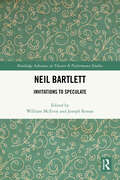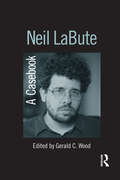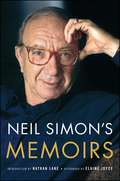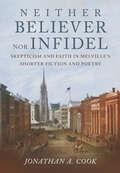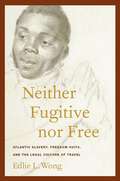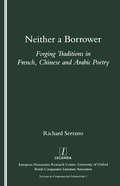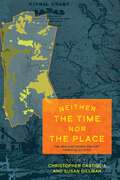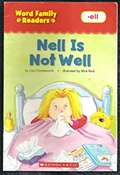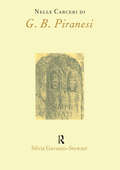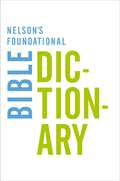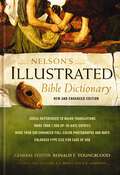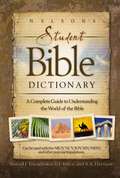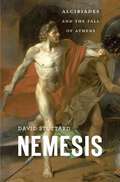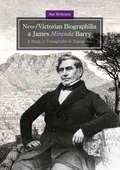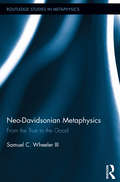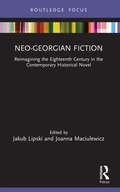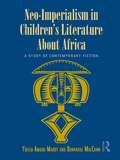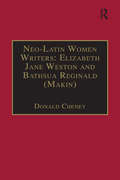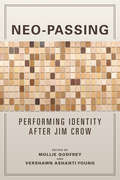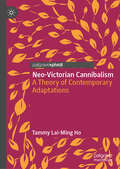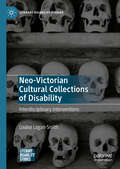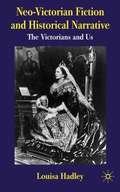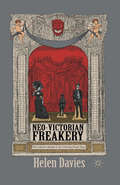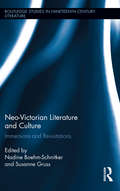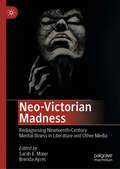- Table View
- List View
Neil Bartlett: Invitations to Speculate (Routledge Advances in Theatre & Performance Studies)
by William McEvoy Joseph RonanThis book explores Neil Bartlett’s groundbreaking contributions to queer cultural production in the United Kingdom. It adopts a range of critical perspectives, presenting original scholarship on Bartlett’s fiction, theatre, performance, site-specific work, and adaptations, as well as more personal reflections on Bartlett’s influence and legacy.Charting his emergence as a radical queer artist in the 1970s, his writing for performance and theatre in the 1980s to the present day, and his evocative novels about queer spaces and hidden histories, the book considers Bartlett’s works as ‘invitations to speculate’: to view and imagine otherwise, as part of a political aesthetics committed to making queer lives visible. Bartlett’s bold, sensuous, and challenging work crosses genres to find new ways of articulating queer desires, unearthing histories of the body, pleasure, and gay subjectivity while connecting queer experiences across time.Dealing with topics including memory and loss, AIDS and its legacy, marginality, community, and identity, the collection shows how Bartlett embraces the past as a way of reimagining queer futures and demonstrates his status as one of the UK’s leading queer artists.
Neil LaBute: A Casebook (Casebooks on Modern Dramatists)
by Gerald C. WoodNeil LaBute: A Casebook is the first book to examine one of the most successful and controversial contemporary American playwrights and filmmakers. While he is most famous, and in some cases infamous, for his early films In the Company of Men and Your Friends and Neighbors, Labute is equally accomplished as a playwright. His work extends from the critique of false religiosity in Bash to examinations of opportunism, irresponsible art, failed parenting, and racism in later plays like Mercy Seat, The Shape of Things, The Distance From Here, Fat Pig, Autobahn, and the very recent This Is How It Goes and Some Girls. Like David Mamet, an acknowledged influence on him, and Conor McPhereson, with whom he shares some stylistic and thematic concerns, LaBute tends to polarize audiences. The angry voices, violent situations, and irresponsible behavior in his works, especially those focusing on male characters, have alienated some viewers. But the writer's religious affiliation and refusal to condone the actions of his characters suggest he is neither exploitive nor pornographic. This casebook explores the primary issues of the writer's style, themes, and dramatic achievements. Contributors describe, for example, the influences (both classical and contemporary) on his work, his distinctive vision in theater and film, the role of religious belief in his work, and his satire. In addition to the critical introduction by Wood and the original essays by leading dramatic and literary scholars, the volume also includes a bibliography and a chronology of the playwright's life and works.
Neil Simon's Memoirs
by Neil SimonThe complete memoirs of playwright Neil Simon--the author of such iconic works as Lost in Yonkers, The Odd Couple, Biloxi Blues, and The Goodbye Girl--now with a new introduction and afterword.This omnibus edition combines Neil Simon's two memoirs, Rewrites and The Play Goes On, into one volume that spans his extraordinary five-decade career in theater, television, and film. Rewrites takes Simon through his first love, his first play, and his first brush with failure. There is the humor of growing up in Washington Heights (the inspiration for his play Brighton Beach Memoirs) where, despite his parents' rocky marriage and many separations, he learned to see the funny side of family drama, as when his mother screamed thinking she saw a body on the floor in their apartment--it turned out to be the clothes his father discarded in the hallway after a night of carousing. He describes his marriage to his beloved wife Joan, and writes lucidly about the pain of losing her to cancer. The Play Goes On adds to his life's story, as he wins the Pulitzer Prize and reflects with humor and insight on his tumultuous life and meteoric career. Now, with the whole story in one place, Neil Simon's collected memoirs trace the history of modern entertainment over the last fifty years through the eyes of a man who started life the son of a garment salesman and became the greatest--and most successful--American playwright of all time.
Neither Believer nor Infidel: Skepticism and Faith in Melville's Shorter Fiction and Poetry
by Jonathan A. CookShedding new light on both classic and lesser-known works in the Melville canon with particular attention to the author's literary use of the Bible, Neither Believer Nor Infidel examines the debate between religious skepticism and Christian faith that infused Herman Melville's writings following Moby-Dick. Jonathan A. Cook's study is the first to focus on the decisive role of faith and doubt in Melville's writings following his mid-career turn to shorter fiction, and still later to poetry, as a result of the commercial failures of Moby-Dick and Pierre. Nathaniel Hawthorne claimed that Melville "can neither believe nor be comfortable in his unbelief," a remark that encapsulates an essential truth about Melville's attitude to Christianity. Like many of his Victorian contemporaries, Melville spent his literary career poised between an intellectual rejection of Christian dogma and an emotional attachment to the consolations of non-dogmatic Christian faith. Accompanying this ambivalence was a lifelong devotion to the text of the King James Bible as both moral sourcebook and literary template. Following a biographical overview of skeptical influences and manifestations in Melville's early life and career, Cook examines the evidence of religious doubt and belief in "Bartleby, the Scrivener," "Cock-a-Doodle-Doo!," "The Encantadas," Israel Potter, Battle-Pieces, Timoleon, and Billy Budd. Accessible for both the general reader and the scholar, Neither Believer Nor Infidel clarifies the ambiguities of Melville's pervasive use of religion in his fiction and poetry. In analyzing Melville's persistent oscillation between metaphysical rebellion and attenuated belief, Cook elucidates both well-known and under-appreciated works.
Neither Fugitive nor Free: Atlantic Slavery, Freedom Suits, and the Legal Culture of Travel (America and the Long 19th Century #8)
by Edlie L. WongPart of the American Literatures Initiative Series Neither Fugitive nor Free draws on the freedom suit as recorded in the press and court documents to offer a critically and historically engaged understanding of the freedom celebrated in the literary and cultural histories of transatlantic abolitionism. Freedom suits involved those enslaved valets, nurses, and maids who accompanied slaveholders onto free soil. Once brought into a free jurisdiction, these attendants became informally free, even if they were taken back to a slave jurisdiction—at least according to abolitionists and the enslaved themselves. In order to secure their freedom formally, slave attendants or others on their behalf had to bring suit in a court of law.Edlie Wong critically recuperates these cases in an effort to reexamine and redefine the legal construction of freedom, will, and consent. This study places such historically central anti-slavery figures as Frederick Douglass, Olaudah Equiano, and William Lloyd Garrison alongside such lesser-known slave plaintiffs as Lucy Ann Delaney, Grace, Catharine Linda, Med, and Harriet Robinson Scott. Situated at the confluence of literary criticism, feminism, and legal history, Neither Fugitive nor Free presents the freedom suit as a "new" genre to African American and American literary studies.
Neither a Borrower: Forging Traditions in French, Chinese and Arabic Poetry
by Richard A. Serrano"In his studies of borrowing from distant poetic traditions, Serrano aims to uncover the heterogenity of influences and intentions in the most canonical of texts: ""Mallarme"" (1842-98), ""Segalen"" (1878-1919), ""Wang Wei"" (701-61), the ""Classic of Poetry"" (8th century BCE), ""Buhturi"" (821-97), and the ""Qur'an"" (7th century CE). Arguing, among other things that Mallarme was really a Chinese poet, that ancient Chinese poets discovered the workings of film imagery, and that the Qur'an's apparently disjointed narrative is profoundly lyrical, Serrano intends to overturn accepted notions of how to read individual works. He brings methodologies from the study of one literature to bear on the reading of another."
Neither the Time nor the Place: The New Nineteenth-Century American Studies
by Susan Gillman Christopher CastigliaThe usefulness of time and place as defining categories would seem to be baked into the very notion of nineteenth-century American literary studies, yet they have challenged scholars practically since the field's inception. In Neither the Time nor the Place seventeen critics consider how the space-time dyad has both troubled and invigorated Americanist scholarship in recent decades and make explicit how time and place are best considered in tandem, interrogating each other.Taken together, the essays challenge depictions of place and time as bounded and linear, fixed and teleological, or mere ideological constructions. They address both familiar and unexpected objects, practices, and texts, including a born-digital Melville, documents from the construction of the Panama Canal, the hollow earth, the desiring body, textual editing, marble statuary, the sound of frogs, spirit photography, and twentieth-century Civil War fiction. The essays draw on an equally wide variety of critical methodologies, integrating affect studies, queer theory, book history, information studies, sound studies, environmental humanities, new media studies, and genre theory to explore the unexpected dimensions that emerge when time and place are taken as a unit. The pieces are organized around considerations of citizenship, environment, historiography, media, and bodies—five political, cultural, and/or methodological foci for some of the most provocative new work being done in American literary studies.Neither the Time nor the Place is a book not only for scholars and students already well grounded in the study of nineteenth-century American literature and culture, but for anyone, scholar or student, looking for a roadmap to some of the most vibrant work in the field.Contributors: Wai Chee Dimock, Stephanie Foote, Matthew Pratt Guterl, Coleman Hutchison, Rodrigo Lazo, Caroline Levander, Robert S. Levine, Christopher Looby, Dana Luciano, Timothy Marr, Dana D. Nelson, Ifeoma C. Kiddoe Nwankwo, Mark Storey, Matthew E. Suazo, and Edward Sugden.
Nell Is Not Well (Word Family Readers:)
by Liza CharlesworthWhen Nell starts to feel not-so-well, her mother sends her to bed with a bell to ring in case she needs anything, in a book that teaches "-ell" words to young readers.
Nelle Carceri di G.B.Piranesi
by Silvia Gavuzzo-Stewart"This title focuses on an Italian architect and engraver of the 18th century - Piranesi. In this book it is argued that Piranesi grants a metaphorical meaning to the Carcesi - a set of etchings - in order to impriso those he saw as obstructing the arts and threatening his own freedom. In light of the growing academic interest in Italy and the re-organization of many university courses in Italian, this series aims to bring together di fferent scholarly perspectives on Italy and its culture."
Nelson's Foundational Bible Dictionary with the New King James Version Bible
by Katherine HarrisThe Bible was written for people to read, ponder, and understand. The message of God's love for humans transcends time, culture, and language. Nevertheless, readers of the Bible are often left with questions. The names sound strange to our ears, the geography is often unfamiliar, and we ask, "Who was this person? Is he mentioned somewhere else in the Bible?" "When did this happen?" "Where did it happen?" "Is this a real city?" Nelson's Foundational Bible Dictionary seeks to answer questions like these and many more. Features include: Every person mentioned in the Bible with biblical references and biographical information All animals and minerals mentioned in the Bible with definitions Modern equivalents of ancient geographical names Key theological terms with their various meanings and interpretations Common household items and occupations with cultural and historical information about life in ancient timesIn addition to the full Dictionary materials, the eBook version of Nelson’s Foundational Bible Dictionary also contains an appendix of the full text of the New King James Version Bible. All verse references in the Dictionary are linked to that verse in the Bible so that you can easily navigate between the Dictionary and Bible text.
Nelson's Illustrated Bible Dictionary: New and Enhanced Edition
by Ronald F. YoungbloodThe most comprehensive and up-to-date Bible dictionary available. With a fresh new look and updated photographs, this new and enhanced edition is a wealth of bible study information for any level of study. It includes more than 7,000 entries, plus more than 500 full-color photographs, maps, and pronunciation guides.Features include:Cross-references to all major translationsMore than 7,000 up-to-date entriesMore than 500 full-color photographs and mapsEnlarged type size for easier readingVisual Survey of the Bible from The Open Bible
Nelson's Student Bible Dictionary: A Complete Guide to Understanding the World of the Bible
by Ronald YoungbloodNelson's Student Bible Dictionary presents nearly 2,000 definitions, representing the best in biblical scholarship, in a convenient and colorful package. Photographs, illustrations, charts, maps, and topical entries invite browsing and make Bible study fun. You will want to take Nelson's Student Bible Dictionary wherever you take your Bible.Quotations are from the NKJV, but the dictionary includes references specific to the KJV, NIV, and NRSV. It can be used with any modern English translation of the Bible.
Nemesis: Alcibiades and the Fall of Athens
by David StuttardAlcibiades was one of the most dazzling figures of the Golden Age of Athens. A ward of Pericles and a friend of Socrates, he was spectacularly rich, bewitchingly handsome and charismatic, a skilled general, and a ruthless politician. He was also a serial traitor, infamous for his dizzying changes of loyalty in the Peloponnesian War. Nemesis tells the story of this extraordinary life and the turbulent world that Alcibiades set out to conquer. David Stuttard recreates ancient Athens at the height of its glory as he follows Alcibiades from childhood to political power. Outraged by Alcibiades’ celebrity lifestyle, his enemies sought every chance to undermine him. Eventually, facing a capital charge of impiety, Alcibiades escaped to the enemy, Sparta. There he traded military intelligence for safety until, suspected of seducing a Spartan queen, he was forced to flee again—this time to Greece’s long-term foes, the Persians. Miraculously, though, he engineered a recall to Athens as Supreme Commander, but—suffering a reversal—he took flight to Thrace, where he lived as a warlord. At last in Anatolia, tracked by his enemies, he died naked and alone in a hail of arrows. As he follows Alcibiades’ journeys crisscrossing the Mediterranean from mainland Greece to Syracuse, Sardis, and Byzantium, Stuttard weaves together the threads of Alcibiades’ adventures against a backdrop of cultural splendor and international chaos. Navigating often contradictory evidence, Nemesis provides a coherent and spellbinding account of a life that has gripped historians, storytellers, and artists for more than two thousand years.
Neo-/Victorian Biographilia and James Miranda Barry: A Study in Transgender and Transgenre
by Ann HeilmannSenior colonial officer from 1813 to 1859, Inspector General James Barry was a pioneering medical reformer who after his death in 1865 became the object of intense speculation when rumours arose about his sex. This cultural history of Barry’s afterlives in Victorian to contemporary (neo-Victorian) life-writing (‘biographilia’) examines the textual and performative strategies of biography, biofiction and biodrama of the last one and a half centuries. In exploring the varied reconstructions and re-imaginations of the historical personality across time, the book illustrates that the ‘real’ James Barry does not exist, any more than does the ‘faithful’ biographical, biofictional or biodramatic rendering of a life in a generically ‘stable’ and discrete form. What Barry represents and how he is represented invariably pinpoints the speculative and the performative: reflections and refractions in the looking glass of genre. Just as ‘James Miranda Barry’, as a subject of cultural inquiry, comes into being and remains in view in the act of crossing gender, so neo-Victorian life-writing constitutes itself through similar acts of boundary transgression. Transgender thus finds its most typical expression in transgenre.
Neo-Davidsonian Metaphysics: From the True to the Good (Routledge Studies in Metaphysics)
by Samuel C WheelerMuch contemporary metaphysics, moved by an apparent necessity to take reality to consist of given beings and properties, presents us with what appear to be deep problems requiring radical changes in the common sense conception of persons and the world. Contemporary meta-ethics ignores questions about logical form and formulates questions in ways that make the possibility of correct value judgments mysterious. In this book, Wheeler argues that given a Davidsonian understanding of truth, predication, and interpretation, and given a relativised version of Aristotelian essentialism compatible with Davidson’s basic thinking, many metaphysical problems are not very deep. Likewise, many philosophers' claims that common sense needs to be modified are unfounded. He argues further that a proper consideration of questions of logical form clarifies and illuminates meta-ethical questions. Although the analyses and arguments he gives are often at odds with those at which Davidson arrived, they apply the central Davidsonian insights about semantics, understanding, and interpretation.
Neo-Georgian Fiction: Reimagining the Eighteenth Century in the Contemporary Historical Novel (Routledge Focus on Literature)
by Jakub LipskiThis book contributes to the development of contemporary historical fiction studies by analysing neo-Georgian fiction, which, unlike neo-Victorian fiction, has so far received little critical attention. The essays included in this collection study the ways in which the selected twentieth- and twenty-first-century novels recreate the Georgian period in order to view its ideologies through the lens of such modern critical theories as performativity, post-colonialism, feminism or visual theories. They also demonstrate the rich repertoire of subgenres of neo-Georgian fiction, ranging from biographical fiction, epistolary novels to magical realism. The included studies of the diverse novelistic conventions used to re-contextualise the Georgian reality reflect the way we see its relevance and relation to the present and trace the indebtedness of the new forms of the contemporary novel to the traditional novelistic genres.
Neo-Imperialism in Children's Literature About Africa: A Study of Contemporary Fiction (Children's Literature and Culture #Vol. 60)
by Yulisa Amadu Maddy Donnarae MacCannIn the spirit of their last collaboration, Apartheid and Racism in South African Children's Literature, 1985-1995, Yulisa Amadu Maddy and Donnarae MacCann once again come together to expose the neo-imperialist overtones of contemporary children's fiction about Africa. Examining the portrayal of African social customs, religious philosophies, and political structures in fiction for young people, Maddy and MacCann reveal the Western biases that often infuse stories by well-known Western authors. In the book's introductory section, Maddy and MacCann offer historical information concerning Western notions of Africa as "primitive," and then present background information about the complexity of feminism in Africa and about the ongoing institutionalization of racism. The main body of the study contains critiques of the novels or short stories of eleven well-known writers, including Isabel Allende and Nancy Farmer--all demonstrating that children's literature continues to mis-represent conditions and social relations in Africa. The study concludes with a look at those short stories of Beverley Naidoo which bring insight and historical accuracy to South African conflicts and emerging solutions. Educators, literature professors, publishers, professors of Diaspora and African studies, and students of the mass media will find Maddy and MacCann’s critique of racism in the representation of Africa to be indispensible to students of multicultural literature.
Neo-Latin Women Writers: Printed Writings 1500–1640: Series I, Part Two, Volume 7 (The Early Modern Englishwoman: A Facsimile Library of Essential Works & Printed Writings, 1500-1640: Series I, Part Two #Vol. 7)
by Donald CheneyThis volume contains the work of the only two Renaissance Englishwomen known to have published collections (as opposed to compilations) of their Latin poetry. Elizabeth Jane Weston lived in Prague as a child, her stepfather being alchemist to Rudolph II. Her stepfather's disgrace, imprisonment and death in 1597 left her to try and support her destitute family household with her writing. Her facility at Latin verses and the support of Georg Martinius von Baldhoven quickly led her to international fame. For Poemata we reprint here the copy of the 1602 edition owned by the Folger Shakespeare Library and for Parthenica we reprint the copy of the 1608(?) edition owned by the Houghton Library. Bathsua Reginald (Makin) was the daughter of Henry Reginald, a London school-master. She is said to have been fluent in Greek, Latin and French and to have knowledge also of Hebrew and Syriac. Her Musa virginea Græco-Latino-Gallica of 1616 certainly confirm these claims to have been accurate. She later became tutor to Princess Elizabeth, daughter of Charles I. The work for which she is best known today is An Essay to Revive the Antient Education of Gentlewomen published in 1673. The work reproduced here is the 1616 edition of Musa virginea and as an appendix we also reprint an engraved card showing specimens of script.
Neo-Passing: Performing Identity after Jim Crow
by Mollie Godfrey Vershawn YoungAfrican Americans once passed as whites to escape the pains of racism. Today's neo-passing has pushed the old idea of passing in extraordinary new directions. A white author uses an Asian pen name; heterosexuals live "out" as gay; and, irony of ironies, whites try to pass as black. Mollie Godfrey and Vershawn Ashanti Young present essays that explore practices, performances, and texts of neo-passing in our supposedly postracial moment. The authors move from the postracial imagery of Angry Black White Boy and the issues of sexual orientation and race in ZZ Packer's short fiction to the politics of Dave Chappelle's skits as a black President George W. Bush. Together, the works reveal that the questions raised by neo-passing—questions about performing and contesting identity in relation to social norms—remain as relevant today as in the past. Contributors: Derek Adams, Christopher M. Brown, Martha J. Cutter, Marcia Alesan Dawkins, Michele Elam, Alisha Gaines, Jennifer Glaser, Allyson Hobbs, Brandon J. Manning, Loran Marsan, Lara Narcisi, Eden Osucha, Gayle Wald, and Deborah Elizabeth Whaley
Neo-Victorian Cannibalism: A Theory Of Contemporary Adaptations
by Tammy Lai-Ming HoThis Pivot examines a body of contemporary neo-Victorian novels whose uneasy relationship with the past can be theorised in terms of aggressive eating, including cannibalism. Not only is the imagery of eating repeatedly used by critics to comprehend neo-Victorian literature, the theme of cannibalism itself also appears overtly or implicitly in a number of the novels and their Victorian prototypes, thereby mirroring the cannibalistic relationship between the contemporary and the Victorian. <P><P>Tammy Lai-Ming Ho argues that aggressive eating or cannibalism can be seen as a pathological and defining characteristic of neo-Victorian fiction, demonstrating how cannibalism provides a framework for understanding the genre’s origin, its conflicted, ambivalent and violent relationship with its Victorian predecessors and the grotesque and gothic effects that it generates in its fiction.
Neo-Victorian Cultural Collections of Disability: Interdisciplinary Interventions (Literary Disability Studies)
by Louise Logan-SmithThis book offers new readings and interpretations of the non-normative narratives of ‘freak show’ performers in the Victorian period as they have been reimagined by contemporary fictions, museum exhibitions and other aspects of the heritage experience. The growth of scholarly interest in institutional histories has been mapped by a surge of neo-Victorian fiction about historical performers with disabilities, supported by scholarship in response to these representations. This study offers the first extensive analysis of the continued display of the bodies and artefacts of historical figures linked to the freak show, and the significant theoretical connections between these displays and broader cultural and fictional representations. It argues that museum displays, archives and fictional adaptations intersect through a much more complex and intriguing dialogue than has previously been identified, shedding light on the way in which historical disability functions in the twenty-first century.
Neo-Victorian Fiction and Historical Narrative
by Louisa HadleyPlacing the popular genre of neo-Victorian fiction within the context of the contemporary cultural fascination with the Victorians, this book argues that these novels are distinguished by a commitment to historical specificity and understands them within their contemporary context and the context of Victorian historical and literary narratives.
Neo-Victorian Freakery: The Cultural Afterlife of the Victorian Freak Show
by Helen DaviesNeo-Victorian Freakery explores the way in which contemporary fiction, film, and television has revisited the lives of nineteenth-century freak show performers. It locates the neo-Victorian freak show as a crucial forum for debating the politics of disability, gender, sexuality and race within the genre more broadly.
Neo-Victorian Literature and Culture: Immersions and Revisitations (Routledge Studies in Nineteenth Century Literature)
by Nadine Boehm-Schnitker Susanne GrussThis book provides a comprehensive reflection of the processes of canonization, (un)pleasurable consumption and the emerging predominance of topics and theoretical concerns in neo-Victorianism. The repetitions and reiterations of the Victorian in contemporary culture document an unbroken fascination with the histories, technologies and achievements, as well as the injustices and atrocities, of the nineteenth century. They also reveal that, in many ways, contemporary identities are constructed through a Victorian mirror image fabricated by the desires, imaginings and critical interests of the present. Providing analyses of current negotiations of nineteenth-century texts, discourses and traumas, this volume explores the contemporary commodification and nostalgic recreation of the past. It brings together critical perspectives of experts in the fields of Victorian literature and culture, contemporary literature, and neo-Victorianism, with contributions by leading scholars in the field including Rosario Arias, Cora Kaplan, Elizabeth Ho, Marie-Luise Kohlke and Sally Shuttleworth. Neo-Victorian Literature and Culture interrogates current fashions in neo-Victorianism and their ideological leanings, the resurrection of cultural icons, and the reasons behind our relationship with and immersion in Victorian culture.
Neo-Victorian Madness: Rediagnosing Nineteenth-Century Mental Illness in Literature and Other Media
by Brenda Ayres Sarah E. MaierNeo-Victorian Madness: Rediagnosing Nineteenth-Century Mental Illness in Literature and Other Media investigates contemporary fiction, cinema and television shows set in the Victorian period that depict mad murderers, lunatic doctors, social dis/ease and madhouses as if many Victorians were “mad.” Such portraits demand a “rediagnosing” of mental illness that was often reduced to only female hysteria or a general malaise in nineteenth-century renditions. This collection of essays explores questions of neo-Victorian representations of moral insanity, mental illness, disturbed psyches or non-normative imaginings as well as considers the important issues of legal righteousness, social responsibility or methods of restraint and corrupt incarcerations. The chapters investigate the self-conscious re-visions, legacies and lessons of nineteenth-century discourses of madness and/or those persons presumed mad rediagnosed by present-day (neo-Victorian) representations informed by post-nineteenth-century psychological insights.
